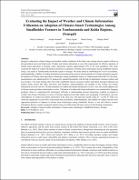| dc.description.abstract | Senegal is subjected to climate change and unstable weather conditions of the Sahel zone causing adverse negative effects on
the agricultural sector and biodiversity. Weather and climate information is one of the requirements for effective adoption of
climate-smart agriculture in Senegal, where Agriculture employs approximately 65% of the total population. This study
evaluated the impact of weather information utilization on adoption of climate-smart technologies among smallholder farmers
using a case study of Tambacounda and Kolda regions in Senegal. The study aimed at establishing the level of accessibility,
understandability, usability of weather information and examined the extent to which utilization of weather information impacts
the adoption of Climate-smart agriculture technologies among smallholder farmers in Tambacounda and Kolda. For this study,
questionnaires were administered to 341 purposively sampled households with the help of department extension workers and
local leaders. The study findings show that while smallholder farmers accessed weather information through traditional and
modern media sources like radio, television, and telephone, understandability and usability of the weather and climate
information received were low. Overall utilization of weather and climate information was low. Also, the overall adoption rate
of climate-smart agriculture technologies was low. Utilization of weather and climate information was constrained by language
problems, failure to comprehend the information, difficulty in understanding forecast terminology, inability to respond to
weather and climate information in terms of farming equipment and other inputs, poor packaging of information, and user
unfriendliness of weather and climate information in the study area. The regression model results (F = 22.203, P=.028) were
within the significant level (p<0.05), which means that accessibility, understandability, and usability of weather forecasts were
appropriate predictors of adoption of climate smart technologies among smallholder farmers. A new and effective weather
information delivery system is proposed and provision of weather-based advisory services to the farming communities. | en_US |


